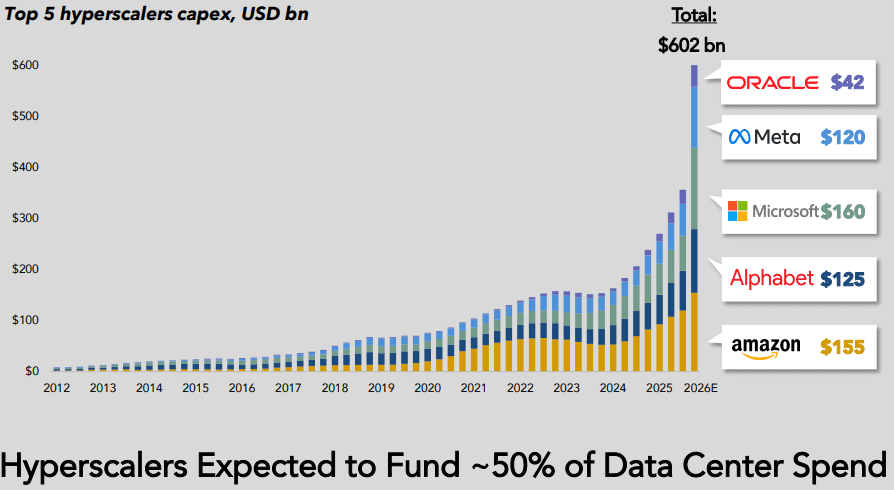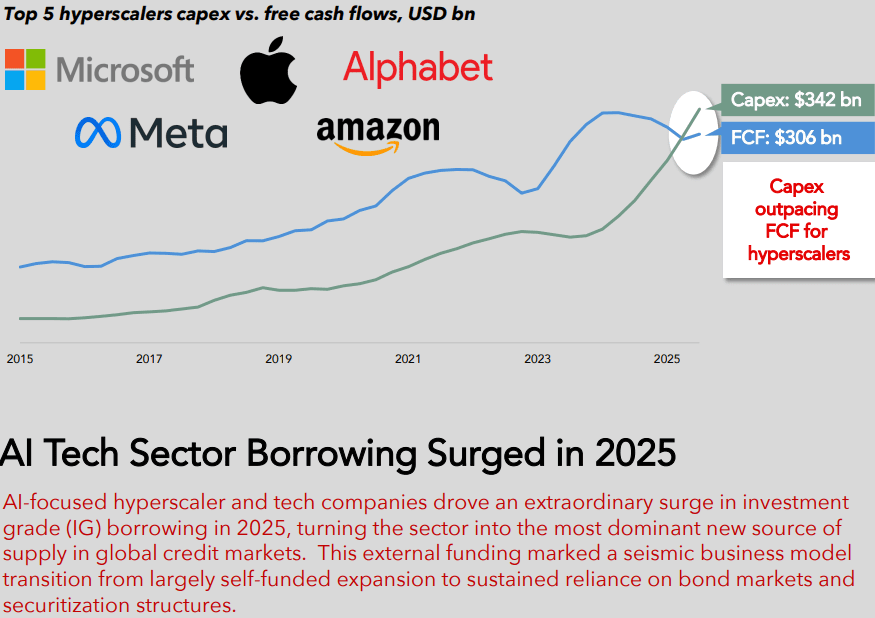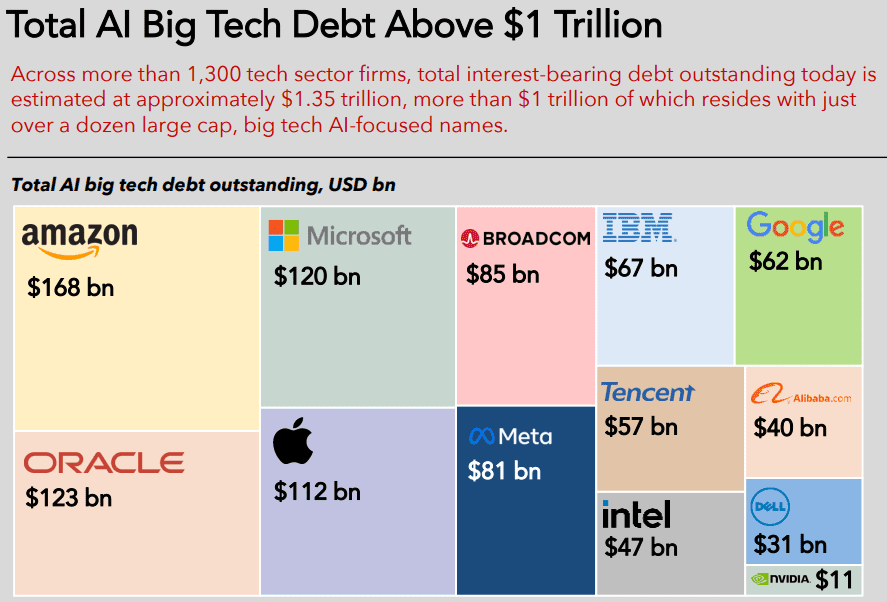Groq and Nvidia in non-exclusive AI Inference technology licensing agreement; top Groq execs joining Nvidia
AI chip startup Groq [1.] today announced that it has entered into a non-exclusive licensing agreement with Nvidia for Groq’s AI inference technology [2.]. The agreement reflects a shared focus on expanding access to high-performance, low cost inference. As part of this agreement, Jonathan Ross, Groq’s Founder, Sunny Madra, Groq’s President, and other members of the Groq team will join Nvidia to help advance and scale the licensed technology. Groq will continue to operate as an independent company with Simon Edwards stepping into the role of Chief Executive Officer. GroqCloud will continue to operate without interruption. It remains to be seen how Groq’s new collaboration with Nvidia will effect its recent partnership with IBM.
Note 1. Founded in 2016, Groq specializes in what is known as inference, where artificial intelligence (AI) models that have already been trained respond to requests from users. While Nvidia dominates the market for training AI models (see Note 2.), it faces much more competition in inference, where traditional rivals such as Advanced Micro Devices have aimed to challenge it as well as startups such as Groq and Cerebras Systems.
Note 2. Training AI models (used by Nvidia GPUs) involves teaching a model to learn patterns from large amounts of data, while AI “inferencing” refers to using that trained model to generate outputs. Both processes demand massive computing power from AI chips.
…………………………………………………………………………………………………………………………………………………………………………………………………….
Groq has achieved a significant financial milestone, elevating its post-money valuation to $6.9 billion from $2.8 billion following a successful $750 million funding round in September. The company distinguishes itself in the competitive AI chip landscape by employing a unique architectural approach that does not rely on external high-bandwidth memory (HBM) chips. This design choice, leveraging on-chip static random-access memory (SRAM), mitigates the supply chain constraints currently impacting the global HBM market.
The LPU (Language Processing Unit) architecture, while enhancing inference speed for applications like chatbots, currently presents limitations regarding the maximum size of AI models that can be efficiently served. Groq’s primary competitor utilizing a similar architectural philosophy is Cerebras Systems, which has reportedly commenced preparations for an initial public offering (IPO) as early as next year. Both companies have strategically secured substantial contracts in the Middle Eastern market.

Nvidia’s investments in AI firms span the entire AI ecosystem, ranging from large language model developers such as OpenAI and xAI to “neoclouds” like Lambda and CoreWeave, which specialize in AI services and compete with its Big Tech customers. Nvidia has also invested in chipmakers Intel and Enfabrica. The company made a failed attempt around 2020 to acquire British chip architecture designer Arm Ltd. Nvidia’s wide-ranging investments — many of them in its own customers — have led to accusations that it’s involved in circular financing schemes reminiscent of the dot-com bubble. The company has vehemently denied those claims.
…………………………………………………………………………………………………………………………………………………………………..
This deal follows a familiar pattern in recent years where the world’s biggest technology firms pay large sums in deals with promising startups to take their technology and talent but stop short of formally acquiring the target.
- A great example of that was Meta which in June invested ~$14.3 billion in Scale AI for a 49% stake in the company. That move valued the startup at around $29 billion. As part of that deal, 28 year old Alexandr Wang resigned as CEO of Scale AI to become Meta’s first-ever Chief AI Officer. He will remain on Scale AI’s board of directors. Wang’s team at the new “superintelligence” lab is tasked with building advanced AI systems that can surpass human-level intelligence.
- In a similar but smaller scale deal, Microsoft agreed to pay AI startup Inflection about $650 million in cash in an unusual arrangement that would allow Microsoft to use Inflection’s models and hire most of the startup’s staff including its co-founders, a person familiar with the matter told Reuters. The high-profile AI startup’s models will be available on Microsoft’s Azure cloud service, the source said. Inflection is using the licensing fee to pay Greylock, Dragoneer and some other investors, the source added, saying the investors will get a return of 1.5 times what they invested.
Bernstein analyst Stacy Rasgon wrote in a note to clients on Wednesday after Groq’s announcement:
“The Nvidia-Groq deal appears strategic in nature for Nvidia as they leverage their increasingly powerful balance sheet to maintain dominance in key areas…..Antitrust would seem to be the primary risk here, though structuring the deal as a non-exclusive license may keep the fiction of competition alive (even as Groq’s leadership and, we would presume, technical talent move over to Nvidia). Nvidia CEO Jensen Huang’s “relationship with the Trump administration appears among the strongest of the key U.S. tech companies.”
…………………………………………………………………………………………………………………………………………………………………………………………………………….
Nvidia CEO Jensen Huang recently dedicated a significant portion of his 2025 GTC 2025 conference keynote speech to emphasize that Nvidia intends to maintain its market dominance as the AI sector increasingly transitions its focus from model training to inference workloads. Huang delivered two major GTC keynotes in 2025: The primary annual conference held in San Jose, California, in March 2025 and a second GTC in Washington, D.C., in October 2025. At these events, he emphasized the rise of “reasoning AI” and “agentic AI” as the drivers for an unprecedented 100x surge in demand for inference computing in just a couple of years. Huang announced that the new Blackwell system, designed as a “thinking machine” for reasoning, was in full production and optimized for both training and large-scale inference workloads.
Huang shared a vision of moving from traditional data centers to “AI factories“—ultra-high-performance computing environments designed specifically to generate intelligence at scale, positioning investment in Nvidia’s infrastructure as an economic necessity.
…………………………………………………………………………………………………………………………………………………………………………………………………………….
References:
https://www.arm.com/glossary/ai-inference
IBM and Groq Partner to Accelerate Enterprise AI Inference Capabilities
Sovereign AI infrastructure for telecom companies: implementation and challenges
AI wireless and fiber optic network technologies; IMT 2030 “native AI” concept
Custom AI Chips: Powering the next wave of Intelligent Computing
OpenAI and Broadcom in $10B deal to make custom AI chips
Reuters & Bloomberg: OpenAI to design “inference AI” chip with Broadcom and TSMC
Analysis: OpenAI and Deutsche Telekom launch multi-year AI collaboration
Expose: AI is more than a bubble; it’s a data center debt bomb
Will the wave of AI generated user-to/from-network traffic increase spectacularly as Cisco and Nokia predict?
Research & Markets: WiFi 6E and WiFi 7 Chipset Market Report; Independent Analysis
According to Research & Markets, the WiFi 6E (IEEE 802.11ax) and WiFi 7 (IEEE 802.11be [1.]) chipset market is expanding rapidly, with projections indicating a rise from $33.65 billion in 2024 to $40.50 billion by 2025, and estimates reaching $149.65 billion by 2032. This growth reflects a notable CAGR of 20.50%, primarily driven by organizations upgrading their wireless networks in response to rising digital application use and increasing data volume.
Note 1. IEEE 802.11be standard was published July 22, 2025. The Project Approval Request (PAR) is here.

Enterprises today require scalable, secure wireless infrastructure capable of supporting diverse and demanding workloads. The latest WiFi chipsets improve network performance, facilitate secure operations, and support robust digital transformation strategies. Adopting Wi-Fi 6E and Wi-Fi 7 chipsets positions organizations to deliver secure, agile connectivity with higher speeds and lower latency.
- Application Areas: Automotive organizations implement advanced chipsets to support secure, reliable vehicle connectivity and enhance driver-assistance systems. In consumer electronics, manufacturers drive higher interactivity and seamless device experiences with updated wireless integration. Enterprises emphasize improved workforce mobility, while healthcare adopts secure, high-speed wireless for telemedicine and remote diagnostics. Industry operators deploy chipsets to enable robotics, automation, and smart manufacturing environments.
- End Users: Commercial enterprises in sectors such as hospitality, offices, and retail seek enhanced connectivity to increase operational efficiency and elevate customer engagement. Industrial segments-including utilities and manufacturing-prioritize automation and resilient communications infrastructure. Residential users focus on smart technology integration and flexible, connected home environments.
- Chipset Technologies: Integrated combo chips provide straightforward deployment for rapid delivery and compatibility, while discrete chipsets offer a tailored approach in high-volume or specialized scenarios. System-on-chip solutions bring high-density integration, maximizing energy efficiency and aligning with sustainability targets.
- Distribution Channels: Organizations maintain robust supply chains utilizing established resellers and digital platforms, ensuring prompt response to evolving logistical demands and market conditions.
- Regional Coverage: The Americas, Europe, Middle East and Africa, and Asia-Pacific each offer unique opportunities and regulatory landscapes, guiding deployment strategies and technology adoption in response to local dynamics.
- Company Profiles: The industry includes innovation-focused leaders such as Broadcom, Qualcomm, and MediaTek. These companies exhibit diverse approaches to integration and product differentiation across the competitive landscape.
Strategic Insights:
- The expanded wireless spectrum empowers businesses to scale connectivity, supporting data-rich operational environments where performance stability and capacity are critical.
- Next-generation chipset architectures enhance automation and real-time data management, particularly in healthcare and manufacturing, strengthening capabilities for time-sensitive applications.
- Collaborations between chipset vendors and device manufacturers improve compatibility, enabling tailored wireless infrastructure to address bespoke enterprise requirements.
- Maintaining a flexible supply approach-leveraging diverse distribution channels-supports organizational agility in facing evolving international trade and supply scenarios.
- Ongoing improvements in wireless security and system reliability support compliance and data protection needs for sectors operating under stringent regulatory requirements.
Market Insights:
- Surge in demand for Wi-Fi 7 chipsets optimized for multi-gigabit data throughput in dense public venues
- Integration of advanced OFDMA and multi-user MIMO enhancements to support simultaneous high-bandwidth applications
- Adoption of 6 GHz spectrum by enterprise networks to enable low-latency connectivity for critical IoT devices
- Development of energy-efficient chipset architectures to extend battery life in mobile and IoT applications
- Emergence of AI-driven adaptive beamforming techniques to improve signal reliability in complex environments
- Strategic partnerships between chipset vendors and cloud providers to accelerate edge computing deployments
- Certification focus on security enhancements such as WPA3-SAE to address evolving wireless threat vectors
- Custom chipset solutions for automotive and industrial automation requiring ultra-reliable low-latency performance
For more information about this report visit: https://www.researchandmarkets.com/r/q1rlgd
…………………………………………………………………………………………………………………………………
Independent Analysis:
The top three WiFi chipset vendors are:
- Broadcom Inc.: Broadcom is generally recognized as the market leader in the Wi-Fi 6/6E and Wi-Fi 7 segment, particularly in terms of revenue share. They supply chips for a wide range of devices, from high-performance consumer routers (e.g., Netgear, Asus models) to enterprise-grade networking equipment, and are a key supplier for platform upgrades like those in flagship smartphones.
- Qualcomm Technologies, Inc.: Qualcomm is a major competitor, especially in the mobile and networking infrastructure segments. Their “FastConnect 7800” chipset has positioned them for significant growth, with Wi-Fi 6E and 7 products expected to comprise a large portion of their Wi-Fi sales in 2025. They are also a primary chip provider for many high-end routers and mesh systems.
- MediaTek Inc.: MediaTek is a strong player, particularly in the consumer electronics space and in Asia-Pacific markets. Their “Filogic 380/880” Wi-Fi 7 chipsets have seen high demand, and they have strong partnerships with major brands like TP-Link and ZTE.
Other WiFi chipset vendors include: Marvell Technology Group, Intel, Realtek Semiconductor Corporation NXP Semiconductors, Texas Instruments, and Samsung Electronics Co. The market is competitive, with these vendors heavily investing in R&D and strategic partnerships to drive the adoption of new Wi-Fi standards from IEEE 802.11 WG.
The top markets for WiFi 6E/7 chipsets are: Smartphones, PC /laptops, Access Point/WiFi routers, CPE /gateways /extenders, industry verticals (e.g. manufacturing, automotive, industrial, home appliances, gaming, augmented reality, etc).
Sources: Gemini, Perplexity AI
……………………………………………………………………………………………………………………………………………………………………..
References:
https://www.ieee802.org/11/PARs/P802_11be_PAR_Detail.pdf
Wireless Broadband Alliance Report: WiFi 7, converged Wi-Fi and 5G, AI/Cognitive networks, and OpenRoaming
WiFi 7: Backgrounder and CES 2025 Announcements
WiFi 7 and the controversy over 6 GHz unlicensed vs licensed spectrum
MediaTek to expand chipset portfolio to include WiFi7, smart homes, STBs, telematics and IoT
MediaTek Announces Filogic Connectivity Family for WiFi 6/6E
Intel and Broadcom complete first Wi-Fi 7 cross-vendor demonstration with speeds over 5 Gbps
Qualcomm FastConnect 7800 combining WiFi 7 and Bluetooth in single chip
Rethink Research: Private 5G deployment will be faster than public 5G; WiFi 6E will also be successful
WBA field trial of Low Power Indoor Wi-Fi 6E with CableLabs, Intel and Asus
Aruba Introduces Industry’s 1st Enterprise-Grade Wi-Fi 6E Access Point
Apple leads 128+% YoY increase in foreign mobile phones shipped within China; Global market share leaders
In November 2025, the volume of foreign-branded mobile phones shipped within China experienced a substantial year-over-year increase of 128.4%. This surge was primarily due to increased sales of Apple iPhones, especially iPhone 17. According to data released by the government-affiliated China Academy of Information and Communications Technology (CAICT), 6.93 million units of international brands were shipped last month. This sharp rise occurred within the context of a broader market increase — total national mobile phone shipments for November reached 30.16 million units, representing a more modest overall year-on-year growth of 1.9%.
The exceptional increase in foreign branded phones is largely attributed to the robust reception of the new iPhone 17 series in the Chinese market. Reports indicate the iPhone 17 line accounted for a substantial portion of Apple’s sales during the period, successfully recapturing market share that had been lost to strong local competition, such as Huawei, throughout the year.
This marks a significant turnaround for Apple in China. In the first month after the iPhone 17 launch, sales reportedly jumped 22% compared to the iPhone 16 launch the previous year. The performance stands in stark contrast to previous periods in 2024 where Apple’s sales had faced challenges and decline due to intensified competition and market saturation. In October 2025, iPhones reportedly accounted for one in every four smartphones sold in China, their highest market share since 2022.
Meanwhile, domestic phone brands like Huawei and Xiaomi saw slower momentum as they delayed some new product launches. That gave Apple a wider sales window and helped foreign brands capture about 23% of the market, compared with roughly 10% in past months.
China brands account for eight of the top 10 global smartphone market share positions after Samsung and Apple.
………………………………………………………………………………………………………………………
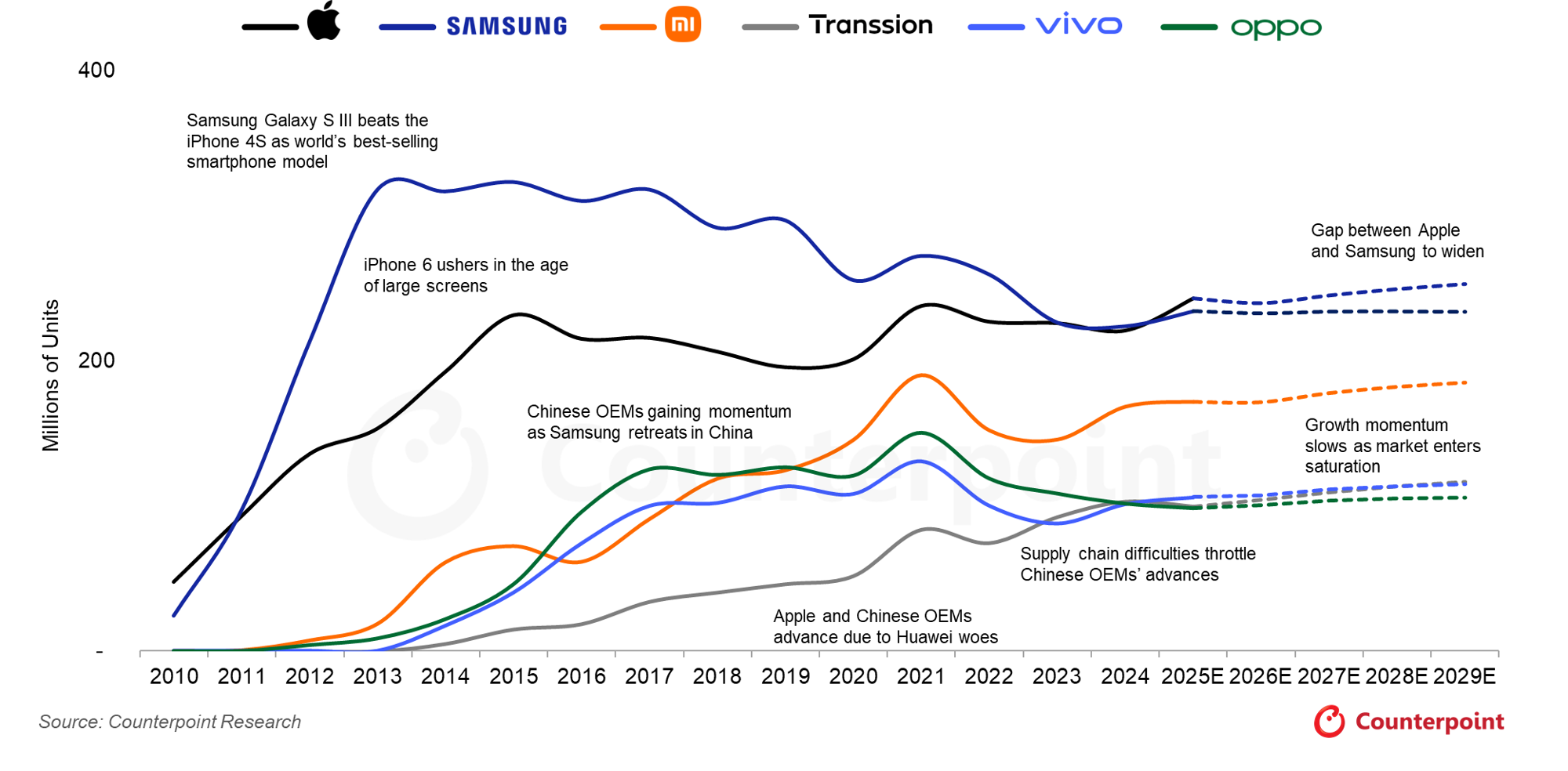
https://counterpointresearch.com/en/insights/Global-Smartphone-Forecast-for-2025
IDC: Worldwide Smartphone Shipment +7.8% YoY; Samsung regains #1 position
Huawei forecast to increase mobile phone shipments despite Android ban
Non-Terrestrial Networks (NTNs): market, specifications & standards in 3GPP and ITU-R
Introduction:
A recent survey showed that Non-Terrestrial Networks (NTNs) are viewed by the telecom industry as reinforcing service reliability and adding an extra layer of network redundancy to 5G. This view increasingly makes the convergence of satellites and 5G (and fiber) a mainstream application in telecoms. With LEO constellation service revenues forecast to reach $15 billion next year, the industry is expected to experience unprecedented growth.
However, that growth will depend on interoperability to realize economies of scale. To achieve that goal NTN standards, regulatory and policy frameworks must evolve to keep pace and ensure equitable access to space for all. As such, we examine the status and future NTN work in 3GPP and ITU-R in this article.
…………………………………………………………………………………………………………………………………………………
3GPP (3rd Generation Partnership Project) has established NTNs as a key part of 5G and future 6G by defining standards in Release 17, which introduced support for satellites and High-Altitude Platforms (HAPS) for direct-to-device (D2D) communication, enabling ubiquitous connectivity. Current work in Release 18 and beyond (including ongoing Release 19 studies) focuses on enhancing performance, expanding spectrum, improving security, and integrating NTNs seamlessly with terrestrial networks for better resource management, leading towards a unified, hybrid telecom ecosystem for global coverage.
- Release 15 & 16 (Foundational): Established NTN use cases, system architectures, and channel models for satellite-based systems.
- Release 17 (First Standardized Release): Introduced the first normative specifications for 5G NR and NB-IoT NTNs, covering GEO and LEO/MEO satellites, addressing technical hurdles like propagation delay and Doppler shift for mass-market devices.
- Release 18 (Enhancements): Studied security aspects, improved 5G NR NTN for higher frequencies (above 10 GHz), and focused on resource management for efficient integration.
- Release 19 & Beyond (Ongoing): Continues to evolve NTNs, introducing features like regenerative payloads, Ku-band support, and further integration for future 5G-Advanced and 6G networks, with studies on 6G architecture.
- Hybrid Networks: Creating a unified framework for seamless terrestrial and non-terrestrial operation.
- Direct-to-Device (D2D) Evolution: Expanding services beyond basic IoT to support smartphones for voice and data in remote areas.
- Technical Refinements: Addressing RF performance, spectrum coordination, and operational complexity for LEO/MEO systems.
- 6G Foundation: Building architectural principles for ubiquitous connectivity that will underpin future 6G systems.
The International Telecommunication Union Radiocommunication Sector (ITU-R) Working Party 4B is actively shaping NTN’s by developing reports and recommendations to integrate satellites (LEO, MEO, GEO) and High-Altitude Platforms (HAPs) with 5G and future 6G cellular networks. The aim is to enable ubiquitous coverage, Direct-to-Device (D2D) services, and seamless hybrid networks, with ongoing work focusing on radio interface specifications, spectrum harmonization, and performance enhancements for reliable connectivity.

- Standardization: ITU-R is finalizing Recommendation ITU-R M.IMT-2020-SAT.SPECS (based on 3GPP’s Release 17/18 specs) to standardize 5G satellite-to-ground communication, supporting IoT and advanced mobile services.
- Working Groups: WP 4B (Satellite services) and other groups are key to defining NTN requirements, spectrum usage, and interoperability.
- Focus Areas:
- Hybrid Networks: Creating seamless service continuity between terrestrial and space/aerial segments.
- Direct-to-Device (D2D): Enabling smartphones to connect directly to satellites.
- Spectrum: Harmonizing spectrum for NTNs, including Ku-band, for expanded services.
- Performance: Addressing challenges like Doppler shift, propagation delay, and handover management for LEO/MEO constellations.
- 3GPP is a crucial partner, introducing NTN frameworks in Release 17 (IoT) and Release 18 (enhanced 5G), with continuous updates for 6G and beyond, closely coordinating with ITU-R.
- ITU-R’s reports discuss future trends, including AI-driven interfaces, diverse terminals (wearables, implants), and the role of NTNs in achieving global, resilient connectivity, supporting Sustainable Development Goals (SDGs).
References:
https://www.gsma.com/solutions-and-impact/technologies/networks/gsma_resources/non-terrestrial-networks-opportunities-and-challenges/
https://www.telecoms.com/satellite/key-non-terrestrial-network-developments-in-2025
https://www.3gpp.org/technologies/ntn-overview
Telecoms.com’s survey: 5G NTNs to highlight service reliability and network redundancy
ITU-R recommendation IMT-2020-SAT.SPECS from ITU-R WP 5B to be based on 3GPP 5G NR-NTN and IoT-NTN (from Release 17 & 18)
Standards are the key requirement for telco/satellite integration: D2D and satellite-based mobile backhaul
GSMAi: key telecom developments in 2025; major trends to watch in 2026
Deutsche Telekom: successful completion of the 6G-TakeOff project with “3D networks”
AST SpaceMobile to deliver U.S. nationwide LEO satellite services in 2026
MTN Consulting: Satellite network operators to focus on Direct-to-device (D2D), Internet of Things (IoT), and cloud-based services
Samsung announces 5G NTN modem technology for Exynos chip set; Omnispace and Ligado Networks MoU
How will fiber and equipment vendors meet the increased demand for fiber optics in 2026 due to AI data center buildouts?
Fiber optic vendors are employing a mix of manufacturing expansion, technological innovation in high-density and next-generation fibers, and strategic supply chain alignment to meet the anticipated surge in demand from AI and data centers in 2026. The demand is so high that at least one major fiber manufacturer, whose name was not explicitly disclosed in news reports, has already sold all its fiber inventory through 2026. Major fiber optic vendors by category are:
- Fiber & Cable Manufacturing: Corning, Prysmian Group, Sumitomo Electric, Fujikura, CommScope, Sterlite Technologies (STL), Yangtze Optical Fibre & Cable (YOFC)
- Optical Transport/Networking: Nokia, Ciena (gaining share), Cisco, Fujitsu, Huawei, Infinera (now part of Nokia)
- Optical Components/Transceivers: Coherent Corporation, Lumentum, Broadcom, Innolight, Accelink
Major focus areas of selected vendors:
- Corning: Leading in fiber cable quality and innovation
- Nokia & Ciena: Strong in optical transport and network solutions, gaining market share
- Cisco & Huawei: Significant players in optical transceivers, catching up to leaders
- CommScope, Clearfield, STL: Preparing for huge demand surges
John McGirr, SVP and general manager for Corning Optical Fiber & Cable, said, “The surge in hyperscale and AI network loads has significantly increased our expectations for fiber demand. Enterprise sales grew 58% year-over-year in Q3 2025, driven by continued strong adoption of Corning’s Gen AI products, largely due to AI network growth demands. The 72-GPU nodes, such as (Nvidia’s) Blackwell, require 16 times more fiber than traditional cloud switch racks. We see no signs of AI network growth slowing down especially as operators scale up (increase computational power by adding more resources within the existing backend AI network node) and scale out (increase the number of nodes to accommodate increasing demand) their networks.”
Rahul Puri, CEO of the Optical Networking Business at STL, said, “AI-focused data centers require significantly more fiber — about 36x more fiber than traditional CPU-based racks — to handle the massive data volumes and high-speed connectivity required by GPU clusters.” Puri predicts that cumulative hyperscale data capacity will increase by three times in the next few years alone. “The U.S. will need to add 213.3 million more fiber miles by 2029, more than doubling its current amount from 159.6 million fiber miles to 372.9 million miles. Our roadmap is shaped directly with the world’s leading cloud, AI and data center operators,”” Puri added.
CommScope’s VP of Technology John Chamberlain and VP of Hyperscale Cloud Erik Gronvall noted that the company has expanded its fiber manufacturing capacity in recent years to meet increased demand. “We are also innovating to reduce the amount of time it takes to deploy AI clusters,” said Chamberlain and Grovall.
………………………………………………………………………………………………………………………………………………………
Fiber Vendor Strategies:
Capacity Increase: Vendors like Corning and CommScope are investing in increasing their production capacity for fiber optic cables and the necessary preforms (raw material for fiber). This includes expanding existing facilities to help alleviate the current supply chain tightness and long lead times.
Technological Innovation in Fiber Design: To support the extreme bandwidth and low-latency needs of AI, vendors are focusing on advanced fiber technologies.
-
- Higher Fiber Counts: Companies are launching cables with extremely high fiber counts (e.g., 1,728+ strands) and higher density options to pack more capacity into existing infrastructure.
- Next-Generation Fibers: Research is ongoing in areas like hollow-core fiber (which uses air or a vacuum to transmit light faster and with less loss) and multicore fiber (multiple cores in one strand to increase capacity). These technologies, while not yet mainstream for 2026, are part of the long-term strategy.
- Bend-Insensitive Fiber: Innovations in bend-insensitive and ultra-high fiber count cables are improving durability and easing deployment in complex data center environments.
Pre-connectorized and Modular Solutions: To counter a persistent skilled labor shortage and speed up deployment, vendors are pushing factory-terminated, plug-and-play fiber systems and modular platforms (like Siemon’s LightStack). These solutions require less on-site expertise and reduce installation time.
Strategic Partnerships and Supply Chain Alignment: Vendors are forming strategic collaborations with hyperscalers and network operators (like the agreement between Corning and Lumen) to align manufacturing platforms with future demand and ensure supply. They are also working to optimize supply chains and, in some cases, regionalize manufacturing to reduce lead times.
Structured Cabling and Photonics: There is a renewed focus on structured cabling architectures, as recommended by some AI platform providers, to ensure predictable, low-latency performance and simpler long-term management. The industry is also exploring integrated photonics to address the power and thermal challenges of future systems.
Focus on AI-Specific Demands: Vendors recognize that AI data centers require up to five times more connectivity than traditional hyperscaler topologies and network architectures. Their strategies are specifically tailored to high-volume, intra-bay, inter-bay, and middle-mile fiber connections to link distributed data center clusters into a single, unified AI computing environment.

…………………………………………………………………………………………………………………………………………………………………………………………………………………………………………………………………
Ciena and Nokia:
- Ramping up Production: Ciena is accelerating the production of 800G ZR+ optical pluggables, with plans to ship a large volume in 2026 to major cloud providers who are currently testing the technology.
- New Architectures: The company is developing new interconnect solutions under the “Scaleacross” architecture designed to support growing AI workloads by significantly increasing capacity and density within the data center.
- Increased Forecasts: Driven by record orders from hyperscalers, Ciena has raised its revenue guidance for fiscal 2026 to a range of $5.7 billion to $6.1 billion, a significant increase that analysts tie directly to AI-driven demand.
- Strategic Positioning: Ciena emphasizes that the network will be the primary limiter of AI performance by 2026, positioning its high-speed fiber solutions as critical for moving massive amounts of data between compute nodes efficiently.
- Major U.S. Investment: Nokia announced a $4 billion investment in U.S. R&D and manufacturing capabilities for “AI-ready” network technologies, including optical and data center networking, to ensure robust domestic supply.
- Strategic Reorganization: Effective at the start of 2026, Nokia will reorganize into two primary segments, one of which is “Network Infrastructure” (including optical networks), which it sees as the center of the “AI supercycle.”
- Industry Collaboration: Nokia has deepened its commitment to the Open Compute Project (OCP) at the Platinum level, aiming to collaborate on open, interoperable AI networking innovations that optimize space, cost, and power efficiency with standards-driven technology.
- Advocacy for Network Modernization: Nokia’s research highlights that current networks are insufficient for future AI growth, advocating for substantial investment and cross-industry collaboration to modernize digital infrastructure to handle the uplink-heavy, distributed data flows generated by AI.
…………………………………………………………………………………………………………………………………………………………….
References:
https://www.fierce-network.com/broadband/major-fiber-vendors-strategize-huge-demand-ai-2026
https://www.fierce-network.com/premium/research/1410126?pk=FN-Research-Commscope-111925-listing
NTT to launch 25 Gps FTTH service in Tokyo starting March 2026
AI wireless and fiber optic network technologies; IMT 2030 “native AI” concept
AI infrastructure investments drive demand for Ciena’s products including 800G coherent optics
AT&T sets 1.6 Tbps long distance speed record on its white box based fiber optic network
China Telecom with ZTE demo single-wavelength 1.2T bps hollow-core fiber transmission system over 100T bps
Lumen and Ciena Transmit 1.2 Tbps Wavelength Service Across 3,050 Kilometers
Co-Packaged Optics to play an important role in data center switches
Coherent Optics: Synergistic for telecom, Data Center Interconnect (DCI) and inter-satellite Networks
Hyper Scale Mega Data Centers: Time is NOW for Fiber Optics to the Compute Server
Microsoft acquires Lumenisity – hollow core fiber high speed/low latency leader
China Mobile to deploy 400G QPSK by the end of 2023
NTT to launch 25 Gps FTTH service in Tokyo starting March 2026
NTT East plans to launch a 25 Gbps Fiber-to-the-Home (FTTH) service in Tokyo starting March 2026, according to Telecompaper, The service will offer significantly faster residential broadband, building on their existing fiber services and recent developments in higher-speed business options. Currently, the highest speed Fiber-to-the-Home (FTTH) access plan commercially available in Japan is 10 Gbps offered by multiple fiber optic network providers, including NTT East/West and Sony-backed NURO Hikari.
NTT’s forthcoming Flet Hikari 25G service will be a best-effort FTTH access product, utilizing shared subscriber fiber to connect customers to their chosen Internet Service Providers (ISPs).
The launch is part of NTT’s broader initiative to develop next-generation digital infrastructure, which also includes the development of key devices for an ultrafast optical network under its “Innovative Optical and Wireless Network” (IOWN) project in 2026.

Source: NTT Access Service Systems Laboratories
Separately, researchers in Japan have set world records for internet transmission speeds using experimental fiber optic technology, reaching speeds of over 1 petabit per second (which is over a million gigabits per second) in laboratory settings. These are research achievements and not a commercially available service for everyday use.
References:
https://www.ntt-review.jp/archive/ntttechnical.php?contents=ntr201604fa6.html
https://www.telecompaper.com/news/ntt-east-and-west-launch-10-gbps-service–1538339
NTT’s IOWN provides ultra low latency and energy efficiency in Japan and Hong Kong
NTT Data and Google Cloud partner to offer industry-specific cloud and AI solutions
Sony and NTT (with IOWN) collaborate on remote broadcast production platform
NTT & Yomiuri: ‘Social Order Could Collapse’ in AI Era
Hyperscaler capex > $600 bn in 2026 a 36% increase over 2025 while global spending on cloud infrastructure services skyrockets
Hyperscaler capex for the “big five” (Amazon, Alphabet/Google, Microsoft, Meta/Facebook, Oracle) is now widely forecast to exceed $600 bn in 2026, a 36% increase over 2025. Roughly 75%, or $450 bn, of that spend is directly tied to AI infrastructure (i.e., servers, GPUs, datacenters, equipment), rather than traditional cloud. Hyperscalers are increasingly leaning on debt markets to bridge the gap between rapidly rising AI capex budgets and internal free cash flow, transforming historically cash-funded business models into ones utilizing leverage, albeit with still very strong balance sheets. Aggregate capex for “the big five”, after buybacks and dividends are included, are now above projected cash flows, thereby necessitating external funding needs.
……………………………………………………………………………………………………………………………………………………………………………………………………………………..
According to market research from Omdia (owned by Informa) global spending on cloud infrastructure services reached $102.6 billion in Q3 2025 — a 25% year-on-year increase. It was the fifth consecutive quarter in which cloud spending growth remained above 20%. Omdia says it “reflects a significant shift in the technology landscape as enterprise demand for AI moves beyond early experimentation toward scaled production deployment.” AWS, Microsoft Azure, and Google Cloud – maintained their market rankings from the previous quarter, and collectively accounted for 66% of global cloud infrastructure spending. Together, the three firms had 29% year-on-year growth in their cloud spending.
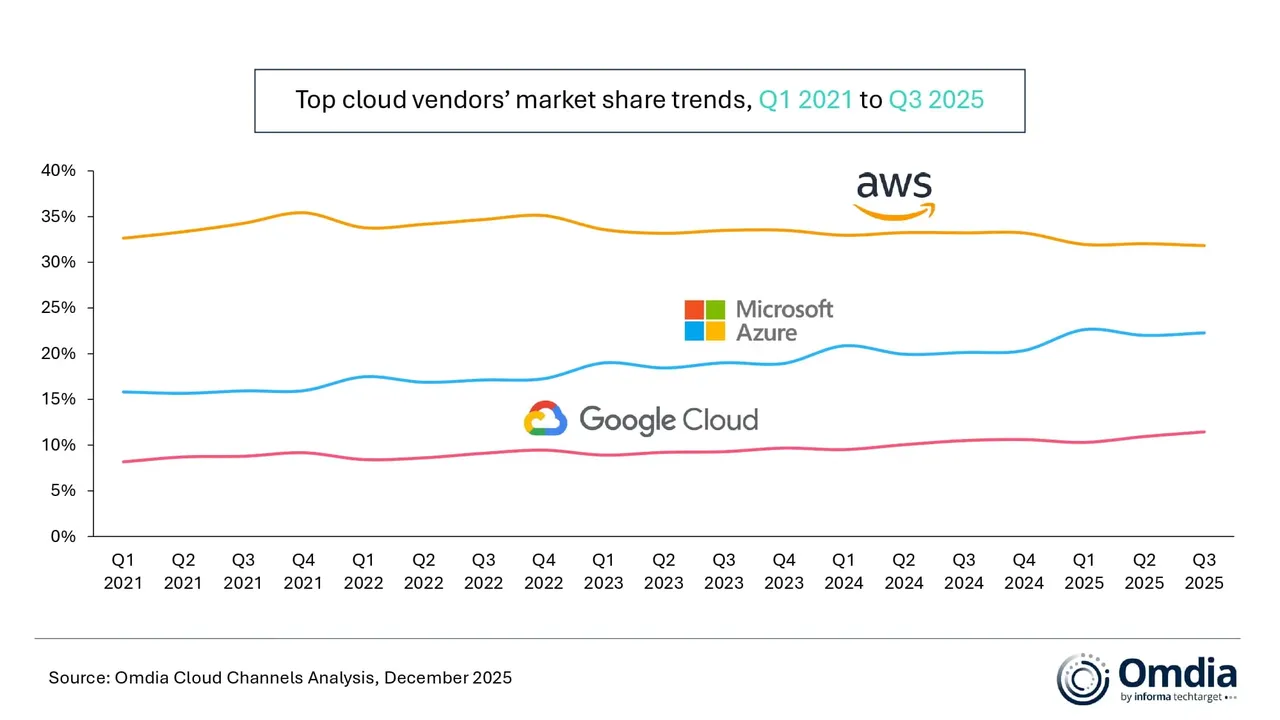
Hyperscaler AI strategies are shifting from a focus on incremental model performance to platform-driven, production-ready approaches. Enterprises are now evaluating AI platforms based not solely on model capabilities, but also on their support for multi-model strategies and agent-based applications. This evolution is accelerating hyperscalers’ move toward platform-level AI capabilities. According to the report, Amazon Web Services (AWS), Microsoft Azure, and Google Cloud are integrating proprietary foundation models with a growing range of third-party and open-weight models to meet these new demands.
“Collaboration across the ecosystem remains critical,” said Rachel Brindley, Senior Director at Omdia. “Multi-model support is increasingly viewed as a production requirement rather than a feature, as enterprises seek resilience, cost control, and deployment flexibility across generative AI workloads.”
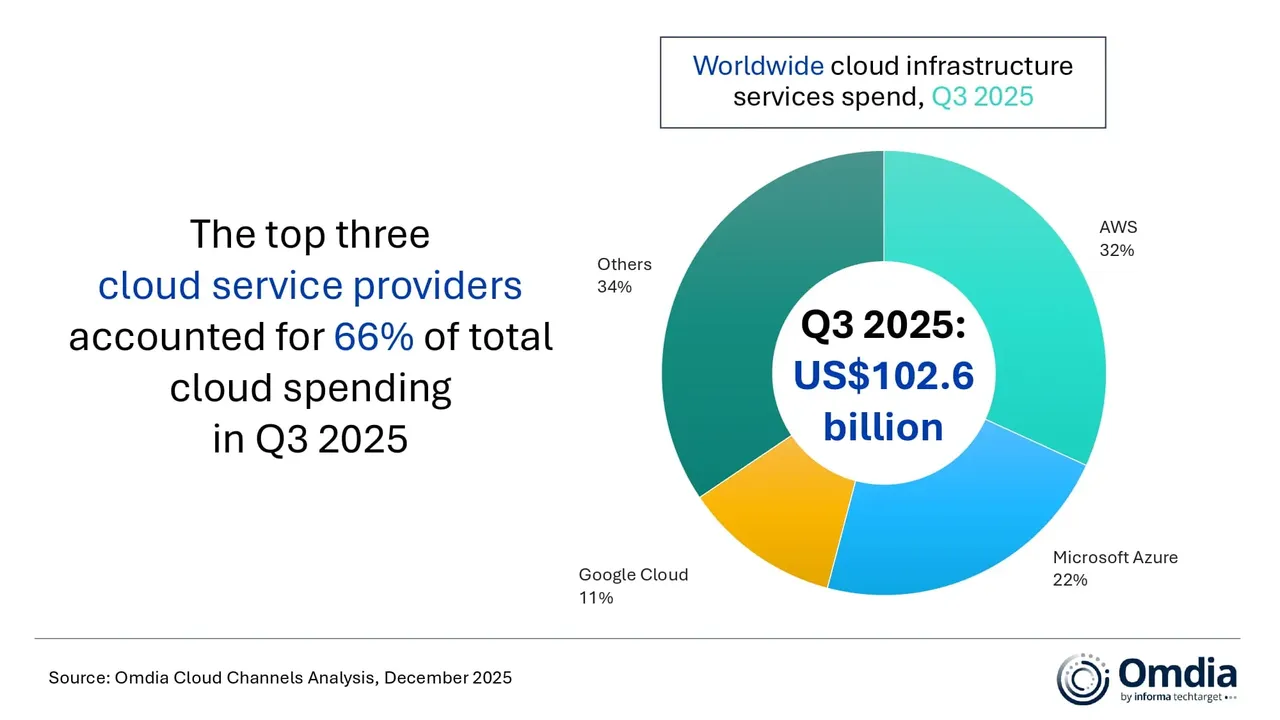
Facing challenges with practical application, major cloud providers are boosting resources for AI agent lifecycle management, including creation and operationalization, as enterprise-level deployment proves more intricate than anticipated.
Yi Zhang, Senior Analyst at Omdia, said, “Many enterprises still lack standardized building blocks that can support business continuity, customer experience, and compliance at the same time, which is slowing the real-world deployment of AI agents. This is where hyperscalers are increasingly stepping in, using platform-led approaches to make it easier for enterprises to build and run agents in production environments.”
This past October, Omdia released a report forecasting that growth of cloud adoption among communications service providers (CSPs) will double this year. It also forecasted a compound annual growth rate (CAGR) of 7.3% to 2030, resulting in the telco cloud market being worth $24.8 billion.
………………………………………………………………………………………………………………………………………………………………………………………………………………………..
Editor’s Note: Does anyone remember the stupendous increase in fiber optic spending from 1998-2001 till that bubble burst? Caveat Emptor!
………………………………………………………………………………………………………………………………………………………………………………………………………………………..
References:
https://www.telecoms.com/public-cloud/global-cloud-infrastructure-spend-up-25-in-q3
https://www.telecoms.com/public-cloud/telco-investment-in-cloud-infrastructure-is-accelerating-omdia
AI infrastructure spending boom: a path towards AGI or speculative bubble?
Expose: AI is more than a bubble; it’s a data center debt bomb
Can the debt fueling the new wave of AI infrastructure buildouts ever be repaid?
AI spending boom accelerates: Big tech to invest an aggregate of $400 billion in 2025; much more in 2026!
Gartner: AI spending >$2 trillion in 2026 driven by hyperscalers data center investments
AI spending is surging; companies accelerate AI adoption, but job cuts loom large
Will billions of dollars big tech is spending on Gen AI data centers produce a decent ROI?
Big tech spending on AI data centers and infrastructure vs the fiber optic buildout during the dot-com boom (& bust)
Canalys & Gartner: AI investments drive growth in cloud infrastructure spending
Sovereign AI infrastructure for telecom companies: implementation and challenges
AI Echo Chamber: “Upstream AI” companies huge spending fuels profit growth for “Downstream AI” firms
Custom AI Chips: Powering the next wave of Intelligent Computing
Palo Alto Networks and Google Cloud expand partnership with advanced AI infrastructure and cloud security
- End-to-End AI Security from Code to Cloud: Customers can protect live AI workloads and data on Google Cloud, including instances on Vertex AI and Agent Engine, using Palo Alto Networks Prisma AIRS. Securing key developer tools like the Agent Development Kit (ADK) with Prisma AIRS provides a secure foundation for developing next-generation AI applications on Google Cloud. This includes capabilities such as AI Posture Management, AI Runtime Security™, AI Agent Security for autonomous systems, AI Red Teaming, and AI Model Security.
- AI-Driven, Next-Generation Software Firewall (SWFW): Palo Alto Networks VM-Series firewalls, designed for securing cloud and virtualized environments via deep packet inspection and Threat Prevention, will feature deep integrations with Google Cloud to help customers maintain robust security policies and accelerate cloud adoption.
- AI-Driven Secure Access Service Edge (SASE) Platform: Palo Alto Networks Prisma SASE platform secures access and networking for remote users and branch offices. Deeper integration with Google Cloud’s native AI services will improve the user experience by leveraging Google’s network for Prisma Access execution and utilizing Google Cloud Interconnect for consistent security policies across multi-cloud WAN infrastructure.
- Simplified and Unified Security Experience: The deep engineering alignment ensures that joint solutions are pre-vetted and optimized for seamless interoperability, reducing integration complexity and operational overhead for security teams. This enables faster deployment of protective measures, simplified compliance, and a unified security posture across the entire hybrid multicloud ecosystem.
- BJ Jenkins, President, Palo Alto Networks: “The critical question for modern governance boards is how to leverage AI without introducing undue risk. This partnership provides the definitive answer. We are eliminating the operational friction between security and development, delivering a unified platform where cutting-edge security is an inherent component of innovation. By embedding our AI-powered security deeply into the Google Cloud infrastructure, we are transforming the platform into a proactive defense system.”
- Matt Renner, President and Chief Revenue Officer, Google Cloud: “Enterprises increasingly rely on the combined capabilities of Google Cloud and Palo Alto Networks for seamless application and data security. This partnership expansion guarantees our joint clientele access to the necessary solutions for securing their most critical AI infrastructure and developing secure-by-design AI agents from inception.”

About Palo Alto Networks:
As the global AI and cybersecurity leader, Palo Alto Networks (NASDAQ: PANW) is dedicated to protecting our digital way of life via continuous innovation. Trusted by more than 70,000 organizations worldwide, we provide comprehensive AI-powered security solutions across network, cloud, security operations and AI, enhanced by the expertise and threat intelligence of Unit 42®. Our focus on platformization allows enterprises to streamline security at scale, ensuring protection fuels innovation. Explore more at www.paloaltonetworks.com.
Palo Alto Networks, Prisma, Prisma AIRS, and the Palo Alto Networks logo are trademarks of Palo Alto Networks, Inc. in the United States and in jurisdictions throughout the world. All other trademarks, trade names, or service marks used or mentioned herein belong to their respective owners.
About Google Cloud:
Google Cloud is the new way to the cloud, providing AI, infrastructure, developer, data, security, and collaboration tools built for today and tomorrow. Google Cloud offers a powerful, fully integrated and optimized AI stack with its own planet-scale infrastructure, custom-built chips, generative AI models and development platform, as well as AI-powered applications, to help organizations transform. Customers in more than 200 countries and territories turn to Google Cloud as their trusted technology partner.
- Learn more about Palo Alto Networks and the Google Cloud partnership here.
- Please see References below for Google Cloud initiatives
……………………………………………………………………………………………………………………………………………………………….
References:
https://www.paloaltonetworks.com/engage/global-multi-platform-security/palo-alto-devops-in
NTT Data and Google Cloud partner to offer industry-specific cloud and AI solutions
Google Cloud targets telco network functions, while AWS and Azure are in holding patterns
Deutsche Telekom and Google Cloud partner on “RAN Guardian” AI agent
Google Cloud announces TalayLink subsea cable and new connectivity hubs in Thailand and Australia
Ericsson and Google Cloud expand partnership with Cloud RAN solution
Google Cloud infrastructure enhancements: AI accelerator, cross-cloud network and distributed cloud
T-Mobile and Google Cloud collaborate on 5G and edge compute
Cloud RAN with Google Distributed Cloud Edge; Strategy: host network functions of other vendors on Google Cloud
Casa Systems and Google Cloud strengthen partnership to progress cloud-native 5G SA core, MEC, and mobile private networks
Google Cloud expands footprint with 34 global regions
GSMAi: key telecom developments in 2025; major trends to watch in 2026
Introduction:
During a recent GSMA Intelligence (GSMAi) webinar, key developments in the 2025 telecom sector were identified. They include satellite communications expansion/partnerships, eSIM proliferation, and industry consolidation.
Projections for 2026 suggest that 6G evolution (in 3GPP and ITU-R WP 5D) and artificial intelligence (AI) will have the greatest impact within the telecom space.
Mergers & Acquisitions:
Radhika Gupta, GSMAi’s Head of Data Acquisition, asserted that 2025 marked a pivotal shift, signaling that “ice finally broke on consolidation” within the telecommunications sector. The completion of the Vodafone UK and Three UK merger is cited as primary evidence, reducing the UK market from four major competitors to three.
“This particular event is important because Europe historically had been very particular about not approving such mergers that shrink a market from four players to three players for competition reasons. Even in the UK, back in 2016, Three and O2 [now Virgin Media O2] attempted to merge, which was not approved by the European Commission on competition reasons only.”
- A mandatory £11bn joint network investment plan over eight years for infrastructure upgrades.
- Capped consumer tariffs for three years to mitigate price escalation.
- Pre-set wholesale prices for three years, ensuring fair access for Mobile Virtual Network Operators (MVNOs).
“While I don’t think we will see satellite providers overtaking terrestrial services, as some have speculated, it shows that direct-to-device is a formidable trend right now… operators representing almost 70% of [the global mobile] market share has at least one satellite partnership with companies like Starlink,” Hatt added.
Editor’s Note: AST SpaceMobile, Iridium and Skylo and other satellite network operators are also making similar partnerships with cellular network operators to offer direct-to-device (D2D) satellite connectivity. The use cases are emergency texting and future voice/data, aiming to eliminate mobile dead zones by connecting standard smartphones to LEO satellites. These collaborations leverage existing mobile networks and spectrum to provide ubiquitous coverage, with AT&T and Verizon focusing on AST SpaceMobile and T-Mobile partnering with Starlink for expanded services.
 Image Credit: European Space Agency
Image Credit: European Space Agency
Accelerating eSIM Adoption and OEM Strategy:
GSMA, ETSI, IEEE, ITU & TM Forum: AI Telco Troubleshooting Challenge + TelecomGPT: a dedicated LLM for telecom applications
GSMA Vision 2040 study identifies spectrum needs during the peak 6G era of 2035–2040
Gartner: Gen AI nearing trough of disillusionment; GSMA survey of network operator use of AI
GSMA: China’s 5G market set to top 1 billion this year
Highlights of GSMA study: Mobile Net Zero 2024, State of the Industry on Climate Action
Sovereign AI infrastructure for telecom companies: implementation and challenges
Sovereign AI infrastructure refers to the domestic capability of a nation or an organization to own and control the entire technology stack for artificial intelligence (AI) systems within its own borders, subject to local laws and governance. This includes the physical data centers, specialized hardware (like GPUs), software, data, and skilled workforce. Sovereign AI infrastructure involves a full “stack” designed to ensure national control and reduce reliance on foreign providers. A few key features:
- Policies and technical controls (e.g., data localization, encryption) to ensure that sensitive data used for training and inference remains within the jurisdiction.
- Development and hosting of proprietary or locally tailored AI models and software frameworks that align with national values, languages, and ethical standards.
- Workforce Development: Investing in domestic talent, including data scientists, engineers, and legal experts, to build and maintain the local AI ecosystem.
- Regulatory Framework: A comprehensive legal and ethical framework for AI development and deployment that ensures compliance with national laws and standards.
Why It’s Important – The pursuit of sovereign AI infrastructure is driven by several strategic considerations for both governments and private enterprises:
- National Security: To ensure that critical systems in defense, intelligence, and public infrastructure are not dependent on potentially adversarial foreign technologies or subject to extraterritorial access laws (like the U.S. CLOUD Act).
- Economic Competitiveness: To foster a domestic tech industry, create high-skilled jobs, protect intellectual property, and capture the significant economic benefits of AI-driven growth.
- Data Privacy and Compliance: To comply with stringent local data protection regulations (e.g., GDPR in the EU) and build public trust by ensuring citizen data is handled securely and according to local laws. Cultural Preservation: To train AI models on local datasets and languages, preserving cultural nuances and avoiding bias found in generalized, globally trained models.

Image Credit: Nvidia
………………………………………………………………………………………………………………………………………………………………………………………………………..
Governments around the world are starting to build sovereign AI infrastructure, and according to a new report from Morningstar DBRS, which opines that major telecommunications companies are uniquely positioned to benefit from that shift. Here are a few take-aways from the report:
- Sovereign AI funding opens a new growth path for telcos – Governments investing in domestic AI infrastructure are increasingly turning to operators, whose network and regulatory strengths position them to capture a large share of this emerging market.
- Telcos’ capabilities align with sovereignty needs – Their expertise in large-scale networks, local presence, and established government relationships give them an edge over hyperscalers for sensitive, sovereignty-focused AI projects.
- Early adopters gain advantage – Operators in Canada and Europe are already moving into sovereign AI, positioning themselves to secure higher-margin enterprise and government workloads as national AI buildouts accelerate.
- Infrastructure Demands: Building robust domestic AI ecosystems requires specialized expertise spanning hardware, software, data governance, and policy.
- Resource Constraints: Dr. Matt Hasan, CEO at aiRESULTS and a former AT&T executive, highlights specific bottlenecks:
- Compute Density at Scale.
- Spectrum Allocation amidst political pressures.
- Energy Demand exceeding existing grid capacity.
- Intensified Reliability Requirements: Sovereign AI implementation places heightened demands on telecom providers for system uptime, reliability, quality, and data privacy. This necessitates a focus on efficient power consumption, resilient routing and backups, robust encryption, and comprehensive cybersecurity measures.
- Supply Chain Vulnerabilities: Geopolitical tensions introduce risks to the supply of critical components such as GPUs and specialized chips, underscoring the interconnected nature of global hardware supply chains.
- The rapid evolution of AI technology mandates continuous investment and technical agility to ensure sovereign deployments remain current.
- The interplay between global hyperscalers and regional telecom operators is expected to shift.
- Hasan predicts a collaborative model, with regional telcos leveraging their position as sovereign partners through joint ventures, rather than an outright displacement of hyperscalers.
References:
Telcos Across Five Continents Are Building NVIDIA-Powered Sovereign AI Infrastructure
https://www.rcrwireless.com/20251202/ai/sovereign-ai-telcos
Subsea cable systems: the new high-capacity, high-resilience backbone of the AI-driven global network
Analysis: OpenAI and Deutsche Telekom launch multi-year AI collaboration
AI infrastructure spending boom: a path towards AGI or speculative bubble?
Market research firms Omdia and Dell’Oro: impact of 6G and AI investments on telcos
Omdia: How telcos will evolve in the AI era
OpenAI announces new open weight, open source GPT models which Orange will deploy
Expose: AI is more than a bubble; it’s a data center debt bomb
Can the debt fueling the new wave of AI infrastructure buildouts ever be repaid?
Custom AI Chips: Powering the next wave of Intelligent Computing
AI spending boom accelerates: Big tech to invest an aggregate of $400 billion in 2025; much more in 2026!
IBM and Groq Partner to Accelerate Enterprise AI Inference Capabilities
Dell’Oro: Analysis of the Nokia-NVIDIA-partnership on AI RAN


